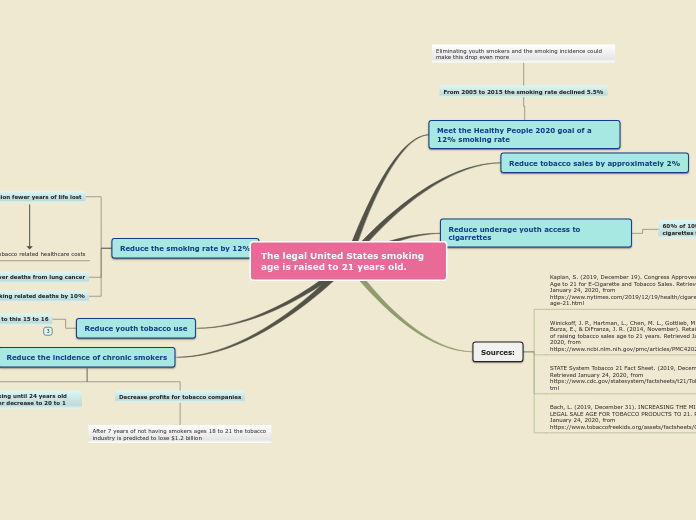The legal United States smoking age is raised to 21 years old.
Meet the Healthy People 2020 goal of a 12% smoking rate
From 2005 to 2015 the smoking rate declined 5.5%
Eliminating youth smokers and the smoking incidence could make this drop even more
Reduce tobacco sales by approximately 2%
Reduce underage youth access to cigarrettes
60% of 10th graders say it would be easy to get cigarettes from many sources
Older siblings
Older classmates
Sources:
Kaplan, S. (2019, December 19). Congress Approves Raising Age to 21 for E-Cigarette and Tobacco Sales. Retrieved January 24, 2020, from https://www.nytimes.com/2019/12/19/health/cigarette-sales-age-21.html
Winickoff, J. P., Hartman, L., Chen, M. L., Gottlieb, M., Nabi-Burza, E., & DiFranza, J. R. (2014, November). Retail impact of raising tobacco sales age to 21 years. Retrieved January 24, 2020, from https://www.ncbi.nlm.nih.gov/pmc/articles/PMC4202948/
STATE System Tobacco 21 Fact Sheet. (2019, December 17). Retrieved January 24, 2020, from https://www.cdc.gov/statesystem/factsheets/t21/Tobacco21.html
Bach, L. (2019, December 31). INCREASING THE MINIMUM LEGAL SALE AGE FOR TOBACCO PRODUCTS TO 21. Retrieved January 24, 2020, from https://www.tobaccofreekids.org/assets/factsheets/0376.pdf
Reduce the smoking rate by 12%
4.2 million fewer years of life lost
Reduce tobacco related healthcare costs
50,000 fewer deaths from lung cancer
Reduce smoking related deaths by 10%
Reduce youth tobacco use
45% reduction in sales to this 15 to 16
Reduce the incidence of chronic smokers
If someone does not start smoking until 24 years old their odds of becoming a smoker decrease to 20 to 1
Decrease profits for tobacco companies
After 7 years of not having smokers ages 18 to 21 the tobacco industry is predicted to lose $1.2 billion
